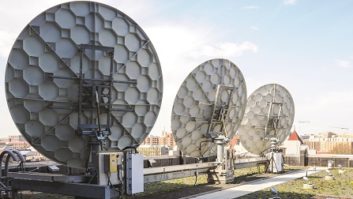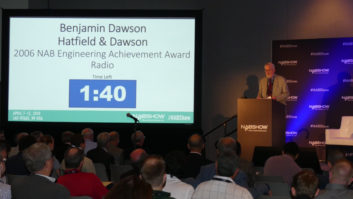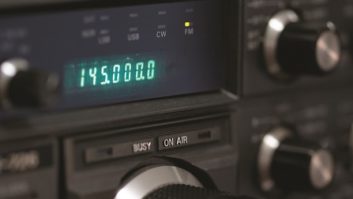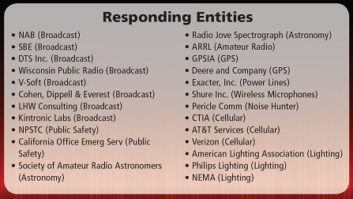Any proposal affecting FM translator priorities must balance a variety of interests.
The FM spectrum is shared by many organizations that benefit from translators — even low-power FM stations (which may rebroadcast over translators, though not own them).

The author works a job site in southern California. A broadcast engineer since 1989, he has managed radio projects in all 50 states and six other countries. He writes: ‘We are fighting battles in self-interest within our ranks. NAB, NPR, REC, EMF, indies … the list goes on.’ These interests include large commercial FM group owners; local or regional FM small-group ownership; NCE FM public broadcasting, funded by NPR and community support; NCE FM large church or religious organizations operating more than 50 broadcast properties; NCE FM small church or religious organizations operating smaller regional networks or single stations; NCE FM small “indie” non-religious organizations; large commercial AM groups; “mom and pop” commercial AM broadcasting owned by small groups; and independent groups leasing full-service FM HD channels and broadcasting over FM translators.
The spectrum is not dominated by any single group, though some certainly share more of it than others.
The FCC should not make regulations to limit ownership on the sole basis that an FM translator is not in the public interest compared to a “local” LPFM voice.
REC Networks, Prometheus Radio Project and Media Access Project are the championing forces behind the LPFM service and its recent success. REC Networks is now touting a proposal it calls “2×70.” Broadcasters and prospective LPFM licensees should read it. The proposal likely would change the way the FCC allocates spectrum to translators and LPFM stations. It has significant merit but is fraught with legal and technical problems.
Lack of accountability
REC says LPFM has a right to service and should have priority over translators where there is little or no LPFM presence. The group also argues that pending applications for translators should be processed in such a way that the FCC prioritizes LPFM against different categories of FM translators according to number of signals owned and proposed translator use.
Its proposal further states that financial speculation on construction permits should be discouraged across all FM ownership lines, including translators. And it says LPFM provides a unique service to the community not found elsewhere on the dial.
Most in the LPFM community, I suspect, would agree with these statements. However, there are other ways of looking at the dial.
Recent posts on an LPFM Internet list discussed whether an LPFM manager could be supported by a salary from the proceeds of an LPFM station. It’s fascinating that while other FM broadcast operators are required to have management and staff presence, LPFM is not.
Further, while full-service radio requires a main studio within a given area so that the public has a place to go to influence content, LPFM does not have this restriction. While full-service broadcasters are required to maintain a public inspection file, LPFMs do not.
With regard to public interest standards, LPFM stations largely are unaccountable to the public; this was deliberate, in order not to burden stations with “undue regulation.” The regulation from which LPFM operators are exempt is the one with the most teeth: accountability to the public in a license renewal proceeding.
Why? Is there a lack of listener support for LPFM? Are the signals just too small to cover major markets? Do LPFM owners want additional influence without the same public responsibility as full-service radio?
I do not, for a moment, imply that the broadcast industry is without its skeletons. LPFM, in general, has taken hold because of the travesty of justice created by FM’s evolution from public trust into commodity; massive speculation in translators in the 2003 filing window; and the public’s lack of access to broadcast spectrum.
Practical concerns
So what is to be done?
First let’s look at some legal, procedural and technical problems with the 2×70 proposal.
It suggests that FM translator applications filed in 2003 should be subjected to technical scrutiny. While the engineer in me says “You da man,” the legal mind says “Really?”
These “applications” are not applications but “expressions of interest.” They cannot be granted on their face. They require companion “long-form” applications that must be technically compliant.
The FCC knows that nothing technical can be judged on the basis of pending “short-form” applications. REC, by forcing the issue, will likely facilitate additional gaming of the system by translator applicants. As Vince Lombardi once said, you must be 15 minutes ahead of your opponent. When you reveal strategy, you let the other guy set the tone for the confrontation.
Also, the 2×70 proposal identifies a criterion to move an LPFM and translators into an area based on pre-existing LPFM service.
Remember that most FCC applications are minor changes to move to another tower and cover a different area. I assume that the LFPM and translator study that forms the basis for the 2×70 proposal cannot predict what the long-form translator applications will look like. This invalidates the study.
The study also may overlook translators that will be blocked on given frequencies by full-service station changes filed since 2003. Whether these translator applicants will be given a chance to submit an engineering amendment for a frequency change in a long-form application is unknown.
Further, REC Networks argues that LPFMs are needed in large cities, aka “urbanized areas.”
In the top 50 markets, as translator owners know, it is difficult to succeed with a single low-power signal. The LPFM community unwittingly has joined other broadcasters in vying for highly coveted spectrum in areas of high population density. It would be disingenuous for prospective LPFM licensees to say they are serving a “local community” when the FCC has defined that community as part of a larger city. The LPFM station would never be able to cover an area of that size, unless the playing field were leveled to allow all service to treat these areas in the same way, which is unlikely.
Humbly submitted
We need fresh ideas. Here are mine.
Many of these are radical, but they are designed to make you think more than to push any agenda.
1. Create an incentive for HD Radio signals to carry LPFM stations.
Require or encourage full-service HD Radio stations capable of multicasting to retransmit prospective LPFM applicants or existing stations. Perhaps offer a reduction in iBiquity licensing costs for those that pledge to air a noncom or LPFM format.
2. Establish a conversion path for translators to become LPFMs.
Since the technical regulation differences are shrinking quickly, let’s allow owners to transfer an FM translator to a qualified LPFM applicant, for the cost of equipment and reasonable license acquisition costs. Compared to the expense involved for an LPFM applicant to obtain a permit, this would be a way to cooperate with a translator owner who acknowledges the validity of local content. No filing window is needed.
3. Resurrect Class D.
These stations existed so schools and educational entities could train students and help them learn how to serve the public. Many old-school engineers were puzzled that an LPFM service was created when one already existed earlier.
4. Allow additional local time on FM translators to give them a chance to prove their desire to serve the public.
Some people say translator owners do not care about the communities they cover; this is a gross misrepresentation. Many serve areas where large numbers of people want certain content. In fact, for some translator owners, local content has become as important as that of the originating station.
I propose a cap of 10 minutes per hour of unique local content on a translator, including up to two minutes of fundraising content.
5. Create new public interest standards for LPFMs such as public file, EAS and staffing requirements, with more accountability on local content.
Just changing the definition of local content would be a good start. The difficulty is that most LPFMs have very limited resources — and “day jobs.” Whether it is possible for most LPFMs to generate local content in a way that significant numbers of local listeners will accept is questionable.
6. Limit the size and scope of translator groups.
This will be unpopular among the largest translator group owners. So be it. In my view, the most effective local service is within a 350-mile radius. In this respect the 2×70 proposal has great merit. Since the FCC does not allow much content origination over a translator, content for a particular area or from a particular originating station will not have truly local or regional interests at heart.
7. Eliminate spectrum auctions.
This will never happen, but the thought drives home that the broadcast world is a commercial one and, as such, cannot be dismissed or eliminated overnight without creating major financial havoc in communities and on a national scale. (It’s fascinating that we may soon see the “public interest” spectrum of broadcast television “reverse-auctioned” to allow for a purely commercial venture — Internet access — to flourish. Is this in the public interest?)
8. Base the FM translator application grant limits on cumulative population.
Distribute FM translator spectrum with no cap of 10 translators but limit the cumulative f(50,50) 60 dBu population total in a long-form proposal to, say, 1 million persons.
For example, if an applicant wanted 50 translators, the average population for each translator would be 20,000 persons. If the applicant wanted 10 translators, it would get an average population of 100,000 per translator. If the applicant wanted one translator, the population cap would be 1 million.
This would be determined on a subsequently filed long-form application, and the translator applicant would have to comply in any settlement proceeding. The spirit of the 2×70 proposal would be preserved but translator grantees would be forced to operate fewer 2003-window translators, making room for LPFM stations in a subsequent window.
This would take the FCC out of the business of deciding who gets into a large city and why. To my knowledge, the largest FM translator in the country serves just over 1.5 million persons in its legal service contour. It would be difficult for a translator to serve more people than that.
There would be no population cap for an LPFM station.
9. Tighten the rules for FM translators to allow not more than one signal of a particular network or station to be allowed in any common area of a 60 dBu contour, regardless of the ownership.
It is a misuse of spectrum for identical signals to be carried in the same legal service area, regardless of the substance of the broadcast.
This change would also lend diversity without the FCC having to get into content regulation.
10. Eliminate second- and third-adjacent-channel protection for FM translators, LPFMs and full-service stations operating under 100 watts.
If a second- or third-adjacent protection regulation is eliminated for LPFM, it should be eliminated for FM translators operating with a power level of 100 watts or under. The Mitre Report has already been generated and the FCC accepts its results.
11. Loosen interference mitigation criteria for LPFM stations fielding interference complaints for second- and third-adjacent channels.
In my professional experience, most such complaints are trumped up. Modern radios have practically eliminated the need for these protections, while new mitigation rules make it easy for an LPFM station to fall prey. A well-funded, full-service FM could bury an LPFM financially just by filing interference complaints, forcing the low-power FM to hire expensive professional technical and legal counsel to mitigate.
12. Establish frequent filing windows with caps of participation.
This will drastically reduce the “pent up” demand for spectrum and reduce speculation and exploitation, if combined with other regulations. Many professionals believe the “Great Translator Invasion” happened because the FCC had not opened a filing window in a very long time. Some large groups that applied for translators saw an opportunity to be the gatekeeper of the distribution of translators for years to come. This alone indicates that the frequency of filing windows is flawed. (Interesting that the FCC still has not disposed of NCE translators filed for in 1997.)
13. Increase the band size.
Proposals by consulting engineers to expand the spectrum to include Channel 5 and 6 make some sense, assuming receiver manufacturers will make new radios with these technical capabilities.
Remember the last time we tried this? I think the first station I converted to HD was 2004. Oh yeah, we are still trying seven years later.
14. Consider a major multiplex (aggregate or SCPC) transmission of the existing FM band based on digital-only HD Radio transition, with an FCC/FTC mandate to force receiver manufacturers to include HD Radio in in-dash IP radios such as Wi-Fi, WiMax, LTE, 4G or other such device capable of receiving an IP audio stream.
Set a date for analog shutdown and force radio receiver manufacturers (including those that make in-dash Internet receivers) to include HD Radio capability, but with more channels.
If the entire FM band were a digital multiplex, we could get many more audio streams into the same spectrum without the use of guard band-type interference protection.
This business of “protection” combined with digital and analog coexistence is incredibly spectrum-inefficient.
15. Eliminate IF protections for FM translators, LPFM and full-service FM with less than 100 watts ERP.
The immediate impact would be to create more opportunities to LPFM in a regulatory practice that has favored translators for years.
Unite
Regardless of which proposal is adopted, if any, the broadcast community more broadly should work together.
One day, some bright engineer at Verizon or AT&T will find a use for our VHF-FM spectrum that would serve consumer demand for data much better than we can in our inefficient “broadcasting” way. Then we might be facing the fate predicted for broadcast television and LPTV.
We are fighting battles in self-interest within our ranks. NAB, NPR, REC, EMF, indies … the list goes on. We might want to start making amends so that looming demands for spectrum do not produce a more sinister solution. None of us can fight that alone.
Meanwhile, translators and LPFMs should remember: You are both secondary services to the FCC, regardless of priority.
Robert H. Branch, Jr., CPBE, is a broadcast technical consultant and ham (N4MUV).










